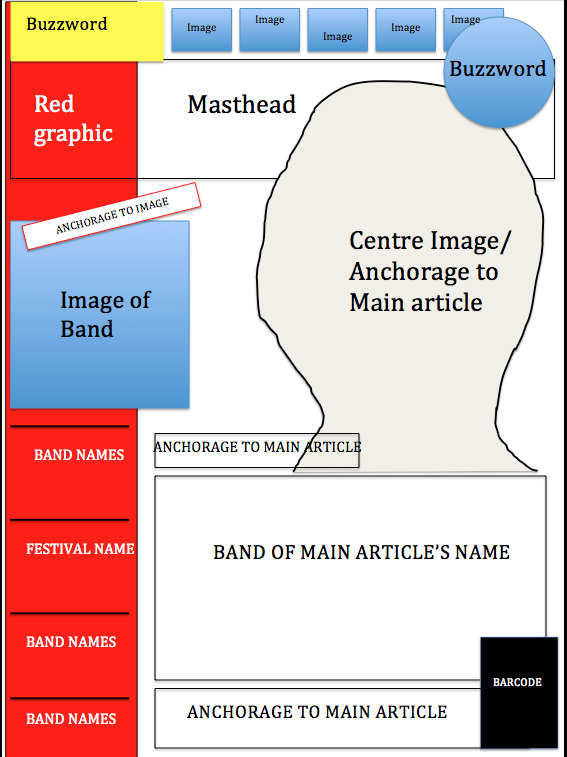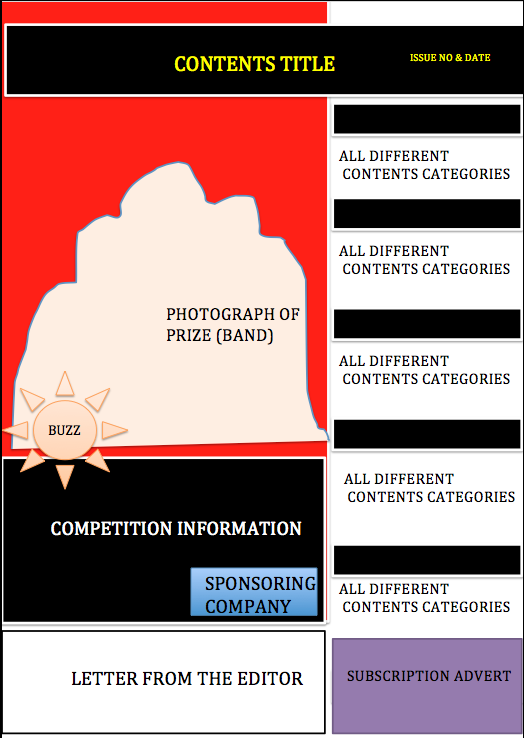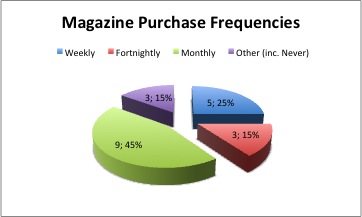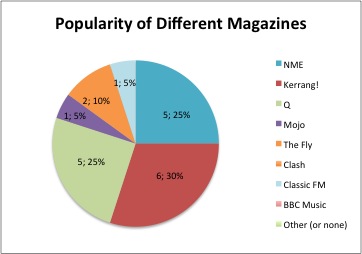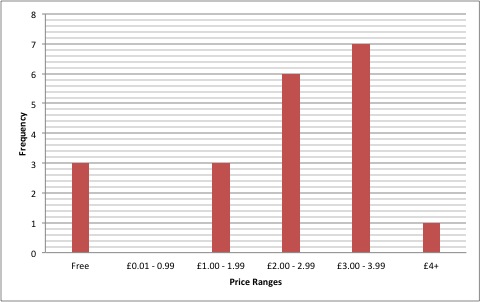
“‘Vibe’ is a music and entertainment magazine founded by producer Quincy Jones. The publication predominantly features R&B and hip-hop music artists, actors and other entertainers. After shutting down production in Summer 2009, Vibe was purchased by the private equity investment fund InterMedia Partners and is now issued quarterly with double covers, with a larger online presence, aided by the Vibe LifeStyle Network, a group of entertainment/music websites under the Vibe brand. The magazine’s target demographic is predominantly young, urban followers of hip-hop culture.” – Wikipedia, 2012.
Magazine Front Cover: Vibe
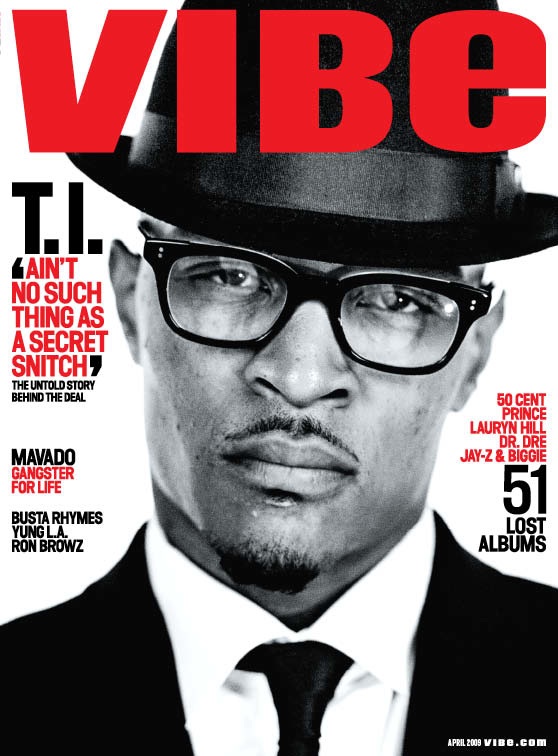
Front Cover of Vibe Magazine
At an instant, the masthead in cooperation with the centre-image create a bold and striking front cover. The contrast between the red, impacting masthead reading ‘VIBE’, and the greyscale-edited photograph of T.I enhance the impact on readers of both the components of this front cover. The graphology has been designed to portray the same colour scheme shown in the masthead and photograph, with the featured cover-lines being red and black – colours that hold connotations of danger and anger, which could represent the genre of music the magazine conveys. The cover-lines are supported by tag lines that briefly summarise the featured article, such as ‘T.I’ being the cover-line and the apparent featured article, and the anchorage text tagline beneath reading ‘Ain’t no such thing as a secret snitch’. This quote supports the article and more anchorage text below that tagline reads ‘the untold story behind the deal’. The photograph’s negative space has been utilised well by the designers as that’s where the text has been placed, thus not making the image too overwhelming. The masthead follows various typical magazine conventions by having similar logos to ‘Mojo’, ‘NME’ and ‘Q’, with the bold and resounding masthead (also red). Contrary to the likes of Rolling Stone Magazine, or Mojo, the masthead is layered above the centre image and is placed central to the splash, and this is because the magazine is much less known than Mojo or Q magazines, where the audience don’t need to directly read a logo/masthead/title. The masthead is also of a much brighter red than that of the cover-lines or any other conventions of the FC, because as they’re a smaller magazine, they want to publicise the title and the brand and make it recognisable.
The centre image covers a great percentage of the splash and has been taken straight on in a close up – which allows the observation of facial features and make direct eye-contact which engages audiences and perhaps intimidates them, which also links in with the angry graphology. This intimidating gesture also links in well with T.I’s persona in the music industry, as well as the publicity he received regarding a prison sentence near the time of the articles publishing. The black and white element of the picture adds to the sophistication of not only the magazine but also the model, along with the clothing he is wearing. The shirt, tie and hat combination gives T.I a classy look, which contrasts with the ‘gangster’ image that is partly associated with him. However, by adding casual glasses this shows that he is not all work and that he is also laid back, connoting that T.I can be relatable despite his position in the music industry.
The cover-lines scattered sparsely around the edges of the cover give readers an idea of what will feature in the magazine, with the most important components being highlighted in red to make them stand out from other conventions – a similar technique to the one used with the masthead. An example of the red and black colours being used to separate and group key information is on the left of the front cover, where several hip-hop stars’ names are listed such as Jay-Z or Dr. Dre, and is accompanied by a black ’51 Lost Albums’ which group all of the red text into that subject/category. Using these cover lines and monochrome theme, the readers can select the content they’d like to read, and by this I am referring to the hint at an interview with T.I, the hint at the ’51 Albums’ reviews, and the information on ‘Busta Rhymes, Yung L.A. and Ron Brownz’ that can be found on the left-hand side of the page. T.I’s name is not in red and the audience already know who the article will be about, due to the largely resounding centre-image, so therefore is less significant, whereas the quote has the ability to draw the reader in more as it shows T.I speaking voice, making the article more personal.
The bar code is placed in the bottom right hand corner of the splash, ensuring that it is away from the main cover line/cover lines, thus keeping the attention towards the main features. Placed under the bar code is the website address of the magazine, http://www.vibe.com/, which lets the readers know where they can find out more about the magazine and therefore broadening the amount of information they can receive about the magazine as a whole. As well as the bar code, a date-line has been placed at the bottom right-hand corner of the page, as it’s not been deemed significant by designers, but has been written in white text, as it sits above a black image (T.I’s suit).
Generally speaking, this FC is successful and elegant in its simplicity. The colour scheme works, the graphology works, and the advertised content works. All of the conventions collaborate to create a wonderfully appealing front cover that drags readers in but doesn’t blind or confuse them with conjunct imagery.
Magazine Contents Page: Vibe

Vibe’s attempt at a cool and contemporary look shines through here, with the ‘Contents’ title appearing on three separate lines, which create an original and stylish title. Having this disjointed effect allows more room on the left-hand side for imagery, and the designers have utilised this space for an image of Kanye West – a huge rap and hip-hop star. After inspection of the title, you are drawn to the figure ‘V’ in the background in italics. This publicises the brand furthermore, despite this not being the front cover, it is an attempt to drum the brand into readers’ minds. These two features are prominent in the majority of Vibe’s’ contents pages, which create this idea for readers that Vibe is contemporary and original, unlike any other magazines.
The pastel-like colours of faded greys allow the ‘Contents’ title to stand above other page conventions, as it’s written in a bold, large format. The columned contents and article information channelled down the right-hand side of the page are also written in bold, black yet stylish fonts, but are obviously just a lot smaller as the audiences will aim to read the contents anyway. The photograph of Kanye West, despite being quite blandly coloured, is the prominent feature in this contents page, as the medium close-up shot allows readers to recognize Kanye West’s ‘devil may care’ attitude and he strikes as intimidating and this engages audience. Kanye West’s sharp and angry look is compensated for with the singularly-coloured heart, that appears in red to strike as the key iconography and convention in the page. This follows the style of the previously studied cover-page as it has the red colouring of key features to highlight the aspects above all other conventions. The heart also connotes love and affection which contrast with Kanye West’s facial expression, and is also, in a sense, anchorage to the contents on the right, stating ‘Is Kante misunderstood?’. Merely having an original photograph of a music icon gives the impression of a prestigious brand that’s at the top of the pack.
The variety of fonts and styles used in the actual lettering present the image as sophisticated and neat, adding to the magazine’s stylish aesthetics. Beside the ‘contents’ title, I noticed the figure ‘1/3’, and I can only assume, as the three referenced articles on the above contents page are all there is regarding article information, that there’s two more pages that give less significant yet more information on articles featured in the magazine. In doing this, Vibe have highlighted their three main articles and have highlighted different types of article, such as the one about death and finance, the one about Kanye’s persona, and a ‘fashion’ subcategory with a referenced article. The magazine appears to present more than just the music of musicians, and actually portrays the fashion and traits of these celebrities – here Kanye West’s clothes represent his cool and collected personality in his music, and the buttoned-up shirt with the cardigan/blazer present him as an intellectual.
The contents page all together achieves its fundamental aims to convey brief article information in the most exciting and appealing way possible.
Vibe Double Page Spread Analysis

Vibe’s artistic house style design seeps through the page through the use of the same Sans Serif lettering in the type face, stand first and quotes on the page. The same font and design featured on the contents and front cover pages – making it a house style. This page also features a horizontal separation between text and graphic that spreads across both pages of this double page spread. The photographs that feature at the top half of the graphic that separates them (a group of five black, bold lines) are intertwined with the actual article at the bottom half through the placement of a dominant photograph that appears above all other conventions, which groups all conventions apparent together. The use of the blue text in the stand first highlight the subject of the article, Solange Knowles, and this stand first is quite significant and controversial, as it brushes aside one of the best-selling female musicians of the 21st century, Beyonce, and highlights her sister as better.
The way that the page has been laid-out is a lot more practical where the reader’s concerned, as the text is grouped to one section and the imagery and graphics separate. The main article is supplemented by a stand first that summarises the article and the subject at hand, in this case Solange Knowles is the featured celebrity. The strip of photos of Solange Knowles that appears along the top of the pages features one enlarged and saturated photograph the still holds its original colours, and is not in black and white unlike the smaller photos on the strip. This large photograph is accompanied by a tagline that features the pricing of the clothing which shows that the magazine is not only interested in the musical aspects of the music industry, but the fashion and cultural aspects too. The right of the central photograph features quotes from the article which not only briefly outline the topics of the interview/article, but they also intrigue readers and enthuse them to read further into the article.
The top left hand corner of the double page spread features some graphics mixed with lettering, which spell out ‘Volume Now’, which is a reference to the ‘modern’ artists and emerging talents, such as Solange Knowles that’s featured on the page. This, along with all other conventions, create an appealing, successful and elusive double page spread.


